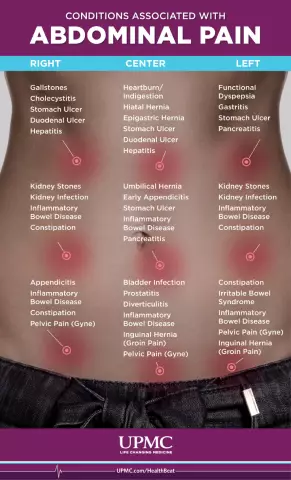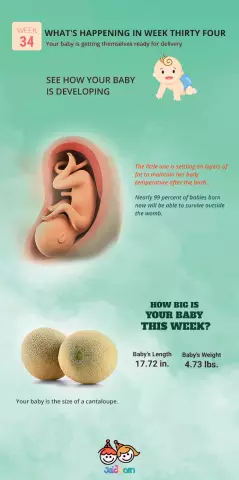- Author Rachel Wainwright [email protected].
- Public 2023-12-15 07:39.
- Last modified 2025-11-02 20:14.
35 weeks pregnant

At 35 weeks gestation, the fetus turns a full 32 weeks from the moment of fertilization, it is the ninth lunar month of pregnancy.
Changes in the fetus
The size of the fetus by ultrasound at 35 weeks of gestation has increased even more, now its length is about 45 - 46 cm, and its weight is 2200 - 2400 g. The daily increase in its mass is normally about 30 g. Maturation of all organs and systems of the unborn baby continues, although the external his appearance is already very close to a full-term newborn.
In the subcutaneous tissue of the fetus at the 35th week of pregnancy, adipose tissue is deposited, the lines of its body are rounded, chubby cheeks appear. The muscle frame is strengthened, which can be felt by the strong shocks of the unborn baby in the stomach at 35 weeks of gestation. The skeleton continues to strengthen, calcium salts are deposited in the bones, which the fetus actively takes from the mother's body.
At 35 weeks gestation, fingernails have grown to the edge of the phalanges, they are very soft and thin. The skin in the folds is still greasy, and there are still traces of lanugo on the shoulders and thighs. The skin of the fetus is much richer in fluid than the skin of an adult, which is why it looks so soft and elastic at birth. A transverse striation of the skin appeared on the feet, it extends to 2/3 of the front surface of the foot. The umbilical ring is located at this stage of pregnancy slightly lower than its usual position, the umbilical cord coming out of it is a cord of their blood vessels and a special type of connective tissue.
During pregnancy, a certain amount of meconium has accumulated in the intestines of the unborn baby. This is the original feces, which was formed in the fetus during the passage of amniotic fluid through the digestive tract. Normally, meconium should leave within a few hours after birth. In the case of a lack of oxygen or fetal suffering at 35 weeks of gestation, the muscular sphincters of the rectum relax, and meconium can still be passed in utero. It stains the amniotic fluid in a greenish color, meconium inclusions can be seen on ultrasound at 35 weeks of gestation.
At 35 weeks of gestation, the adrenal glands begin to mature at an accelerated rate. These endocrine glands are located above the upper pole of the kidneys; they distinguish between the medulla and the cortex, which secrete various groups of hormones. At this stage, the ability to secrete hormones is being improved, which adapts the future baby to stress, which is the approaching birth.
Changes in a woman's body at 35 weeks of gestation

The uterus in the abdomen at 35 weeks of gestation occupies most of the abdominal cavity and small pelvis, its bottom is determined 35 cm above the level of the pubic joint and 15 cm above the navel. For a woman at this time, it is already quite difficult to walk and bear heavy things, more and more often the body requires rest. Under the influence of hormones, the emotional state may again become unstable, and anxiety about future childbirth appears.
A large belly and joints softened under the influence of pregnancy hormones can cause pain at 35 weeks of gestation in the lower back, since an increased load falls on it.
Transparent abundant discharge at 35 weeks of gestation from the genital tract may turn out to be amniotic fluid. During this period, childbirth in a woman can begin according to one of the scenarios - either from contractions or from the discharge of water. An admixture of blood in the discharge at 35 weeks of gestation is always dangerous as a manifestation of placental abruption, which means a disturbance in the life of the fetus. Such bleeding can be dangerous for the life of the woman herself; you should not hesitate in seeking medical help.
Examination at 35 weeks of gestation
At this stage of pregnancy, a weekly visit to the doctor and control of body weight, as well as a general urinalysis are required. Ultrasound at 35 weeks of gestation is not routinely performed. It's time for a third blood test for HIV, syphilis and parenteral hepatitis.
The doctor takes another smear from the vagina from the woman for sowing on the microflora.
YouTube video related to the article:
Found a mistake in the text? Select it and press Ctrl + Enter.






